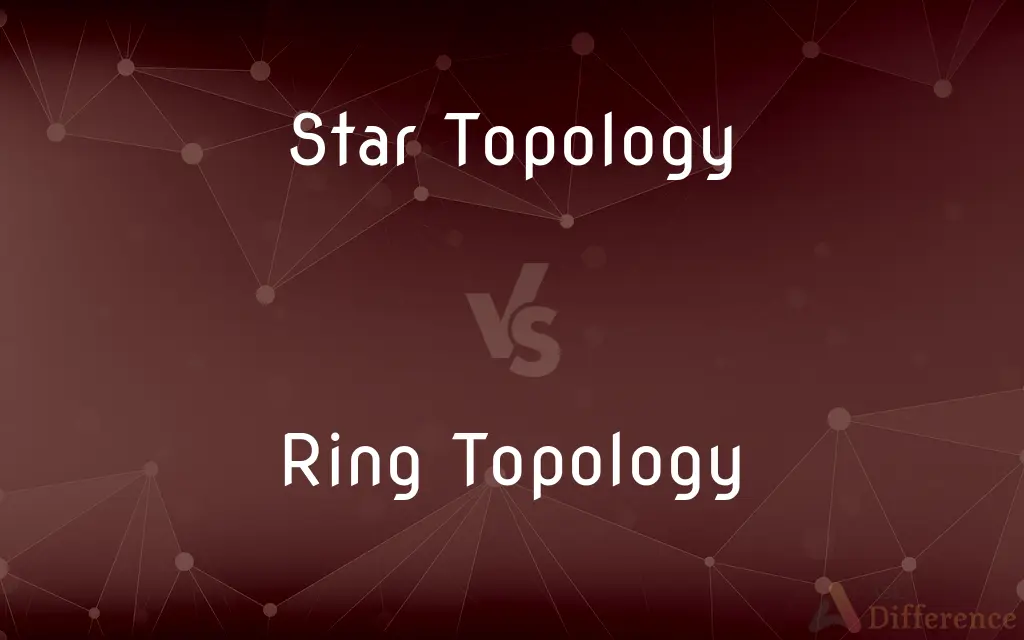Star Topology vs. Ring Topology — What's the Difference?
By Tayyaba Rehman — Published on January 28, 2024
Star Topology connects each node to a central hub, ideal for fault isolation. Ring Topology connects nodes in a closed loop, where data travels in one direction, good for equal data traffic.

Difference Between Star Topology and Ring Topology
Table of Contents
ADVERTISEMENT
Key Differences
Star Topology in network design involves each network device (node) being connected to a central hub or switch. In this setup, each device has a direct, individual connection to the central unit, which manages the network's traffic. In contrast, Ring Topology connects each device directly to two other devices, forming a closed loop. Data in a Ring Topology network travels in one direction, passing through each device until it reaches its destination.
In terms of fault tolerance, Star Topology offers better isolation; if one node fails, it doesn't affect the rest of the network. This makes it easier to identify and fix issues. Conversely, in a Ring Topology, a failure in any single node or connection can disrupt the entire network, making it less fault-tolerant and harder to troubleshoot.
The installation and modification of a network in Star Topology are relatively simple and straightforward due to its centralized nature. Adding or removing devices can be done without disturbing the rest of the network. Ring Topology, however, requires more effort to add or remove nodes, as it involves breaking the ring and can cause network disruption.
Data traffic management differs significantly between the two topologies. In Star Topology, the central hub can become a bottleneck if it's not capable of handling high traffic. In Ring Topology, the data traffic is evenly distributed as each node gets the data in turn, which can be advantageous in networks with equal data distribution needs.
Lastly, the cost implications of both topologies are different. Star Topology requires more cable length and a central hub or switch, which can increase costs. Ring Topology is generally more economical in terms of cabling but might require more network cards or connectors in each device.
ADVERTISEMENT
Comparison Chart
Connection Layout
Each node connected to a central hub
Nodes connected in a closed loop
Fault Tolerance
High, isolated faults
Low, one fault can disrupt the entire network
Network Modification
Easier to add/remove nodes
More complex, as the loop must be broken
Data Traffic Management
Central hub can become a bottleneck
Even distribution of data traffic
Cost
Higher due to central hub and more cabling
Generally lower, but requires more network cards
Compare with Definitions
Star Topology
Simplifies adding or removing nodes.
Expanding our network was easy due to the Star Topology.
Ring Topology
Even distribution of network traffic.
The Ring Topology handles our uniform traffic load efficiently.
Star Topology
Network topology with each node connected to a central hub.
Our office network uses Star Topology for efficient management.
Ring Topology
More complex to modify the network.
Adding a new device to our Ring Topology required network reconfiguration.
Star Topology
Allows for easy fault isolation.
In the Star Topology, when one computer failed, it didn't affect others.
Ring Topology
Network topology where each node is connected to two others in a loop.
Our Ring Topology ensures a continuous data path between all computers.
Star Topology
Risk of central hub becoming a bottleneck.
High network traffic sometimes overloads our Star Topology's hub.
Ring Topology
Data travels in one direction around the ring.
Messages in our Ring Topology network pass through each node sequentially.
Star Topology
Generally more expensive due to additional hardware.
Implementing Star Topology required more investment in cabling and switches.
Ring Topology
A single fault can disrupt the entire network.
A break in the Ring Topology caused a complete network outage.
Common Curiosities
How does Star Topology handle network failures?
It isolates failures to individual nodes, preventing widespread impact.
What is Star Topology used for?
It's used for efficiently managing network traffic through a central hub.
What is the main feature of Ring Topology?
Data transmission in a single direction in a closed loop.
Is Star Topology easy to scale?
Yes, adding or removing nodes is straightforward.
Can Star Topology become a bottleneck?
Yes, if the central hub is overloaded.
Are both topologies suitable for all types of networks?
No, the choice depends on specific network requirements and scale.
How do data speeds compare in both topologies?
Star Topology can offer higher speeds but depends on the hub's capacity.
What happens in Ring Topology if one node fails?
The entire network can be disrupted.
Which topology is more costly to implement?
Star Topology, due to the need for more cabling and a central hub.
How is network modification in Ring Topology?
More complex, as adding/removing nodes requires breaking the loop.
How does traffic flow in Ring Topology?
Traffic flows in one direction, passing through each node.
Is Ring Topology good for large networks?
It can be less efficient for large networks due to its loop structure.
Is Ring Topology suitable for high-traffic networks?
It can be, if the traffic is evenly distributed.
Which topology is easier to troubleshoot?
Star Topology, due to isolated faults.
Which topology is more fault-tolerant?
Star Topology offers better fault tolerance.
Share Your Discovery

Previous Comparison
Will be vs. Would be
Next Comparison
Political Science vs. PolityAuthor Spotlight
Written by
Tayyaba RehmanTayyaba Rehman is a distinguished writer, currently serving as a primary contributor to askdifference.com. As a researcher in semantics and etymology, Tayyaba's passion for the complexity of languages and their distinctions has found a perfect home on the platform. Tayyaba delves into the intricacies of language, distinguishing between commonly confused words and phrases, thereby providing clarity for readers worldwide.












































